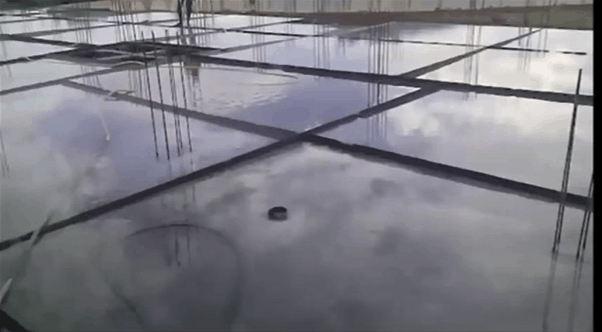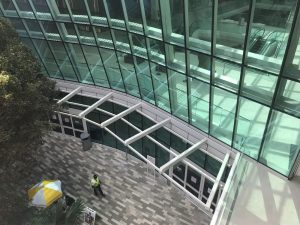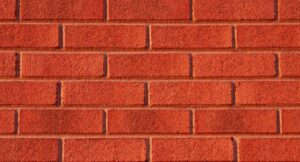Concrete curing plays a crucial role in developing concrete’s strength and durability. It is necessary to maintain the required humidity and temperature conditions for a long time in-depth and near the surface for concrete treatment immediately after concreting is completed. Correctly cured concrete contains sufficient moisture for continuous wetting, forming strength, size stability, freeze and thaw resistance, wear resistance, and volume resistance.
What is the curing of concrete?
Curing of concrete is the process of protecting concrete from moisture loss necessary for the hydration process and keeping it within the recommended temperature range. The Curing of concrete increases the strength and reduces the permeability of the solid concrete. Polymerization also helps reduce thermal cracks and plastic cracks, which can have a significant impact on the durability of the structure.
Reasons for curing of concrete
Curing of concrete cement is necessary for the following reasons:
- Prevent concrete from drying out due to sunlight and wind.
- The concrete temperature is maintained through the hydration process.
- It hardens and adheres to the internal and reinforcing materials. It helps prevent damage to the bond between the concrete and steel bars due to vibration and shock.
- It is used to develop waterproof, crack-free, and durable concrete.
Types of concrete curing
The curing of concrete can be classified mainly with these three curing types:
- A method of keeping water mixed into concrete at an early stage of the hydration process. These include ponds or dives, sprinkling and fogging, and saturated mulch. These methods allow some cooling through evaporation, which is beneficial in hot weather.
- A method for minimizing water mixing losses on the concrete surface. It can be done by covering the concrete with waterproof paper, plastic sheets, or by applying a hardening compound that forms a thin layer.
- A method to accelerate the hydration process by providing additional heat and moisture to concrete. Usually use new steam, heating coil, electric heating form, or bearing to complete it.
Different Methods of concrete curing
- Sprinkling and fogging method
- Wet curing
- Ponding
- Impervious Paper
- Plastic Sheets
- Membrane-Forming Curing Compounds
- Internal Moist Curing
- Forms Left in Place
- Steam Curing
- Insulating Blankets or Covers
- Electrical, Oil, Microwave, and Infrared Curing
Sprinkling and fogging method
When the temperature is above the freezing point, and the humidity is low, Sprinkling is the best way to cure the concrete. The nozzle or spray system is frequently used as a mist to increase the air’s relative humidity that passes through the mold, thus reducing the steam on the surface.
Perform atomization treatment to reduce plastic shrinkage cracks until final processing is complete. Once the concrete is good enough to prevent water erosion, a regular lawn sprayer will be effective if it provides good coverage, and you don’t have to worry about the water flow. Flexible hoses are useful on surfaces that are vertical or close together.
The cost of spraying may be unfavorable. This process requires a water supply and close monitoring. In intermittent spraying, prevent the concrete from drying out using burlap or similar material between the water. Otherwise, alternating wetting and drying cycles can cause the surface to crack.
Wet Curing Method of Concrete Curing
Coverings of water-saturated fabrics, such as burlap, cotton pads, carpets, or other absorbent materials, are usually used for concrete curing. There is treated burlap used that reflects light and is resistant to rot and fire.
Burlap should not contain any substances harmful to concrete or causing discoloration. New burlap should be rinsed well in water to remove soluble materials and make the burlap more absorbent.
After the concrete hardens, a wet and moisture-proof fabric coating should be applied immediately to prevent surface damage.
During the waiting period, use other processing methods such as atomization or the use of finishing agents to form the membrane. Be careful when covering the entire surface with a damp cloth. The edges of the floor must be covered. During the curing period, the paint should always be kept wet, and the water film should be kept on the concrete’s surface.
It is a good practice to use polyethylene film on wet linen. It will eliminate the need for constant watering of the coating. Before drying, it is sufficient to dip it under plastic regularly. Other wetting and drying cycles in the early processing stage may cause perforations on the surface.
The wet coating of soil, sand, or sawdust can be effectively treated and is usually used for small businesses. Sawdust is acceptable for most woods, but oak and other woods containing tannin should not be used because the concrete may deteriorate. A layer of 50 mm (2 inches) thick should be evenly distributed over the concrete’s pre-moistened surface and maintain constant humidity.
Ponding

On flat surfaces (such as sidewalks and floors), concrete can be cured by ponding. Sandy banks around the concrete surface can hold the pond water. Ponding is an ideal way to prevent concrete from losing moisture. It is also effective in maintaining a uniform temperature of concrete. The curing water temperature should not be less than about 11 ° C (20 ° F) of the concrete to prevent heat stress that could cause cracking. Since standing water requires a lot of work and supervision, this method is usually only used for small jobs.
Impervious Paper
Impervious paper for concrete curing consists of two kraft paper pieces affixed with a fiber-reinforced asphalt binder. Waterproof paper complies with ASTM C 171 (AASHTO M 171), a useful tool that can improve horizontal and structural concrete with relatively simple shapes. The vital advantage of this method is that there is no need to add water regularly. Curing with impervious paper can prevent moisture loss in the concrete, thus increasing cement hydration.
If the impervious paper effectively retains moisture, it can be reused. You can use impervious curing paper to quickly fix lacerations and holes. When the paper’s condition is of doubt, additional uses can be achieved by using double thicknesses.
In addition to hardening, the impermeable paper also provides protective measures to prevent damage from construction activities and direct sunlight protection after concrete. It should be light in color and not damage the concrete. White surface paper is best used for curing outdoor concrete in hot weather.
Plastic Sheets
Plastic sheets can be used to cure concrete. Polyethylene film is a lightweight and effective moisture-proof agent that can be easily applied to complex and simple shapes. Its application is the same as describing textured paper.
Concrete curing using polyethylene film (or impermeable paper) can discolor the chips, especially if the concrete contains calcium chloride and is finished to the surface with a solid steel trowel. This color is most noticeable when the film is curled, but it is difficult and time-consuming to lay out the paper without creasing on large projects.
Submerging in the water on the coating layer’s bottom surface can prevent discoloration, but other treatment methods should be used when color is essential. The polyethylene film must meet the requirements of ASTM C 171 (AASHTO M 171), which states that the thickness of the treated concrete is 0.10 mm (4 mils), but only the transparent and white opaque films are listed. However, black films can be used and are satisfactory under certain conditions. White film is used to cure outdoor concrete in hot weather to reflect sunlight. The black film can be used in cold weather or indoors. The transparent film has almost no effect on heat absorption.
Membrane-Forming Concrete Curing Compounds
Liquid membrane-making compounds made of wax, resin, chlorinated rubber, and other materials can be used to delay or reduce water evaporation from the concrete. It is the most practical and most used method for processing newly laid concrete and prolonging concrete treatment after the formwork is removed or after the first treatment with moisture.
However, the most effective way to treat concrete is wet paint or water spraying, keeping the concrete in a constant moisture state. The concrete curing compound should keep concrete surface relative humidity above 80% for seven days to maintain cement wetting.
There are two general types of membrane-forming curing agents: transparent or translucent; And white dyes. Transparent or translucent compounds may contain runaway coatings, and when using this compound, you can easily inspect the entire layer on the surface of the concrete. The paint disappeared soon after application. It is recommended to use a white pigment combination on a hot sunny day; It reduces the sun’s heat gain and lowers the concrete temperature. The dye compound must be shaken in the container to prevent the dye from dissolving.
After the concrete is finished, the hardening compound should be applied immediately by manual or electric spray equipment. When applying the paint, the surface of the concrete must be wet.
During dry or unfavorable weather conditions that can cause shrinkage and plastic cracks, applying a curing agent before the final finish and before all free water evaporates onto the surface will prevent damages from forming.
Automated spray equipment is recommended for large-scale pavement projects for uniform application of curing agents. Nozzles and windshields should be arranged on this equipment to prevent wind treatment vehicles from losing.
The hardening compound prevents adhesion between the hardened concrete and the newly installed concrete coating. Most of the curing agents are incompatible with the adhesives used in flooring materials.
Therefore, when the above materials need to be glued, their compatibility or non-use must be tested. For example, a curing agent should not be applied to the floors of two rows of floors. Likewise, some curing agents will affect the adhesion of the paint on the concrete floor.
Forms Left in Place
If the exposed concrete surface on top remains moist, the formwork can provide satisfactory moisture protection. The suction hose is handy for this. Whenever possible, the shape should be kept on the concrete.
Putting wood mold in place should be kept moist by spraying water, especially in hot and dry weather. If this is not possible, it should be removed as soon as possible, and another treatment method should be started immediately. Rough treatment of moldings and walls with water may lead to color changes.
Steam Curing
In situations where early improvement of concrete strength is essential or additional heating is required to achieve hydration, steam curing is beneficial. There are two curing methods with steam: fresh steam at atmospheric pressure (used in enclosed cast-in-place structures and large precast concrete units) and high-pressure steam in an autoclave (used in small manufacturing units).
Steam curing is usually performed at atmospheric pressure in an enclosed space to reduce moisture and heat losses. Tarpaulin is often used to form shells. The application of steam to the veneer should be delayed until the initial setting occurs, or it should be delayed at least until at least 3 hours after the concrete is finally poured for the concrete to harden. However, a delay of 3 to 5 hours before steaming will achieve maximum early strength.
The steam temperature in the cabinet must be maintained at around 60 ° C (140 ° F) until the required concrete strength is reached. If the maximum steam temperature increases from 60 ° C to 70 ° C (140 ° F to 160 ° F), the strength will not increase significantly. Avoid steam treatment temperatures exceeding 70 ° C (160 ° F). They are not economical and may cause harm. It is recommended that the concrete’s internal temperature not exceed 70 ° C (160 ° F) to avoid delayed expansion due to heat and excessive final strength reduction. Historical field tests or data should demonstrate that it is safe to use temperatures above 70 ° C (160 ° F).
The concrete temperature is usually monitored at the exposed end of the concrete member. Observing the air temperature isn’t enough because the water’s heat can cause the concrete’s internal temperature to exceed 70 ° C (160 ° F). In addition to increasing strength, it can also cure concrete at temperatures around 60 ° C (140 ° F). For example, compared to concrete cured for 28 days at 23 ° C (73 ° F), the drying and creep shrinkage are reduced.
Overheating and cooling should be avoided to prevent damage to volume changes. Depending on the size and shape of the concrete element, the temperature in the envelope surrounding the concrete should not increase or decrease by more than 22 ° C to 33 ° C (40 ° F to 60 ° F) per hour.
The curing temperature must be maintained in the casing until the concrete has reached the required strength. The concrete mix affects the time needed.
Insulating Blankets or Covers
When the temperature drops below 0 ° C (32 ° F), a layer of dry, porous material (for example, straw or hay) may be used to provide insulation to prevent the concrete from freezing.
Insulating blankets or felt insulation materials with robust and moisture-resistant coating can insulate the mold economically. Suitable insulating blankets are made of fiberglass, foam rubber, cellulose fiber, mineral wool, vinyl foam, an open-cell polyurethane foam.
When using insulating formwork, care must be taken to ensure that the concrete’s temperature is not too high. A framed casing made of tarpaulin, reinforced polyethylene film, or other materials can be placed around the structure and heated by space heaters or steam. Portable hydraulic heater for road floor defrosting and concrete heating without casing.
Electrical, Oil, Microwave, and Infrared Curing
Over the years, electrical, thermal oil, microwave, and infrared curing methods have accelerated to standardized concrete. Electro treatment methods include a variety of technologies:
(1) Use the same concrete as a conductor.
(2) Use steel bars as heating elements.
(3) Use special wires as heating elements.
(4) Use steel mold for electric heating (currently the most popular method).
In cold weather, electric heating is beneficial. The hot oil can be circulated through the steel molds to heat the concrete. The applications of infrared and microwave in enhancing concrete curing are limited. Infrared cured concrete is usually closed under a cap or in a solid form. Electric, oil, and infrared curing methods are mainly used in the manufacture of precast concrete.





